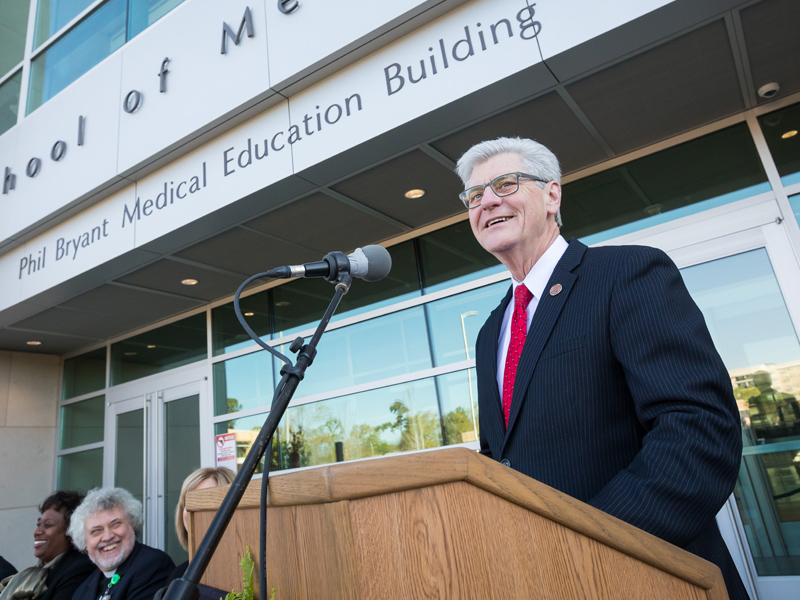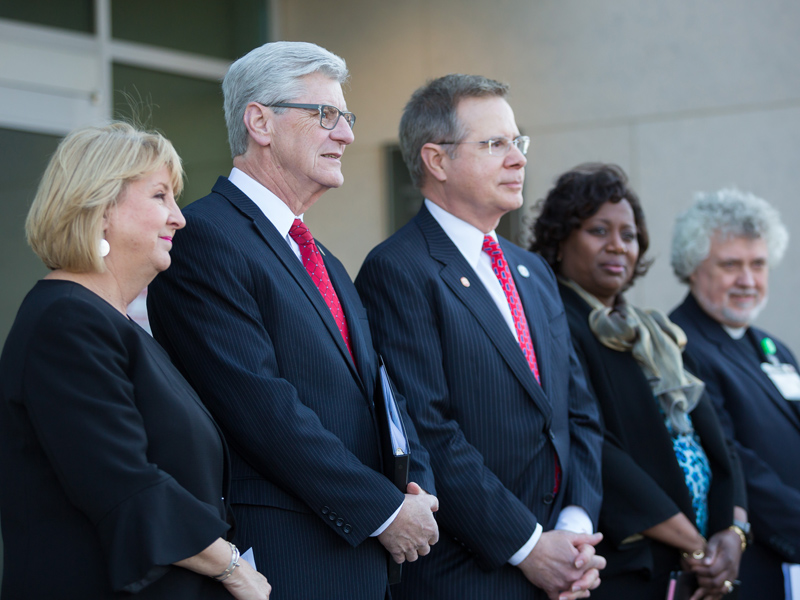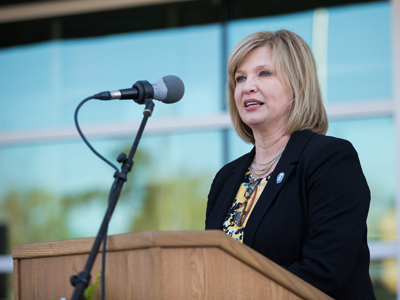Bryant helps realize dream of building that now bears his name

One person called the School of Medicine at the University of Mississippi Medical Center a shining city on a hill.
Another felt it was a joyful revelation. A third proclaimed it part of the legacy of Gov. Phil Bryant.
The state-of-the-art structure that is the academic home to Mississippi’s flagship medical education program officially has a new name: the Phil Bryant Medical Education Building.
During a ceremony Wednesday on the University of Mississippi Medical Center campus, Gov. Bryant and First Lady Deborah Bryant unveiled a new sign on the front of the building.
Working with the Legislature, Gov. Bryant was instrumental in securing funding for the 151,000-square-foot, $76 million building. That support includes $10 million in federal Community Development Block Grant funding through the Mississippi Development Authority to launch the effort, as well as the governor’s help in securing $66 million in state bonds.
His emotions surrounding the honor were “astonishment and surprise,” the governor told a crowd gathered outside the building. It instead could have been named for any number of Mississippi’s medical icons and scores of administrators and faculty “more qualified for this unique honor than I,” he said.
“There is no expression of gratitude that seems proper for this unique and auspicious occasion,” Gov. Bryant said. “My joy cannot be represented on an individual level, but as a collective accomplishment of everyone who had a hand in bringing this day to reality.”

Administrators with the University of Mississippi thanked Gov. Bryant for supporting the mission and future of the School of Medicine. UM Chancellor Jeffrey Vitter lauded the governor for his “unwavering commitment, vision and passion for helping generations of Mississippians lead healthier lives.
“This building and the resulting expanded classes will stand as a part of his legacy,” Vitter said. “Indeed, today is a tremendous celebration in honor of Gov. Bryant and a momentous milestone in the history of our Medical Center and for the state of Mississippi.”
Students began classes in the new building shortly after its August 4, 2017 dedication. It was designed especially for components of the School of Medicine, which was originally in the Medical Center complex that opened in July 1955. Over the years, demands for space have grown, and, as the Medical Center expanded, the medical school splintered into a network of disconnected sites, including some makeshift offices and labs.
Today, there’s a world of difference. The School of Medicine is a place for “living, learning and browsing,” said Dr. Loretta Jackson-Williams, vice dean for medical education and professor of emergency medicine. That compares, she said, to the former “cramped and confined classrooms and a nomadic existence … from this campus to the Jackson Medical Mall.”
Some years ago, Gov. Bryant had a conversation with former UMMC Vice Chancellor for Health Affairs and School of Medicine Dean James Keeton, remembered Dr. LouAnn Woodward, Keeton’s successor.

“Dr. Keeton shared that we’d already begun growing our class size, but that we needed more room,” Woodward recounted. Together, the men voiced a dream: “Let’s put 1,000 new doctors in Mississippi by 2025,” Woodward said.
“With support of the state’s leadership and the Legislature, Gov. Bryant secured funding for the medical education building to make that dream a reality,” she said. “Based on our current enrollment and historic retention rate … I can tell you we’re going to meet that goal. In fact, we’re going to beat that goal.”
The Phil Bryant Medical Education Building includes a cutting-edge simulation training area, which was made possible in part by grants totaling nearly $5 million from the Hearin Foundation. It is also equipped with a mock operating theater, funded by the UMMC Alliance and the Manning Family Fund for a Healthier Mississippi, plus virtual reality spaces with high-fidelity task trainers, a clinical skills center, flexible-use spaces and more.
At roughly 185 doctors per 100,000 residents, Mississippi is the most medically underserved state in the nation. Addressing this issue has been one of Gov. Bryant’s highest priorities. His commitment to increasing the state’s number of physicians was a focal point of his 2013 State of the State address in which he observed that having more providers will create better health care access for Mississippians, resulting in lower costs.
The governor for years has broadly supported medical education efforts in the state. During the 2012 legislative session, Gov. Bryant signed House Bill 317 into law to establish more medical residency programs statewide, a move intended to allow more Mississippi-trained physicians to remain in the state.
That same year, Gov. Bryant championed and signed legislation creating Health Care Industry Zones to spur expanded access to health care and grow health care jobs.
Medical school leaders began increasing class sizes several years ago in anticipation of the new building. The entering class grew from about 145 students to 155 this year, and will eventually top off at approximately 165.
It’s projected that the larger class sizes accommodated by the Phil Bryant Medical Education Building will generate about $1.7 billion in economic impact by 2025, and that the additional physicians trained will support more than 19,000 new jobs by the same year. The economic impact of practicing UMMC-trained physicians is more than $6.3 billion annually, and those physicians are estimated to support more than 60,000 jobs in the state.
As a chilly wind whipped the crowd gathered outside for the unveiling, Gov. Bryant called attention to dozens of medical students who lined five stories of windows inside the warm building. “They seem somewhat tired and stressed,” he said.
“The true purpose of this labor is for the students,” Gov. Bryant said. “These students now have a medical school befitting their talents.”
The School of Medicine’s future, Woodward said, “is brighter. Stronger. Bolder.
“Thank you, governor.”


